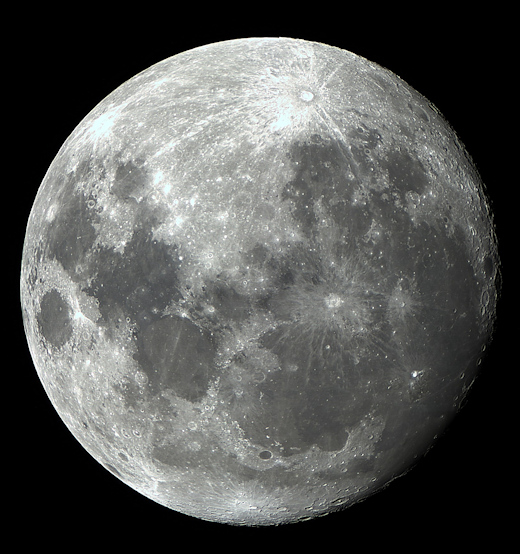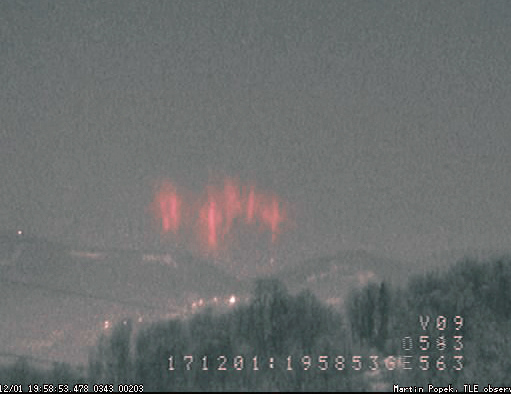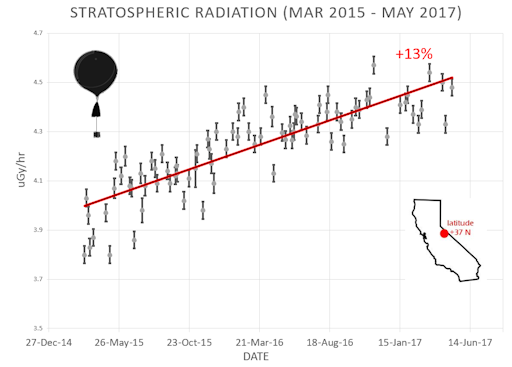All-inclusive Northern Lights trips in Tromsø, Norway. Small groups, big experiences! Highly qualified guides ensure unique and unforgettable adventures with a personal touch. Visit Explore the Arctic | | |
INCREASING CHANCE OF MAGNETIC STORMS: NOAA forecasters have upgraded their estimate of next week's geomagnetic storm from G1-class (minor) to G2-class (moderately strong). These thresholds may be exceeded on Dec. 4th and 5th when a stream of solar wind reaches Earth, blowing past our planet faster than 600 km/s (1.3 million mph). G2-class geomagnetic storms can confuse wildlife that use magnetic cues for navigation and have been known to spark Northern Lights as far south as a line from New York to Wisconsin to Washington state. Free: Aurora Alerts.
WATCH OUT FOR THE SUPERMOON: The biggest and brightest full Moon of 2017 is coming this weekend, on Sunday night, Dec. 3rd. It's a perigee "supermoon," almost 8% wider and 16% brighter than an average full Moon. This morning, Dec. 2nd, Masa Nakamura photographed the waxing orb over Otawara,Tochigi, Japan:

Full moons vary in size because the Moon's orbit is not a circle, it's an ellipse: diagram. One side of the Moon's orbit, called "perigee," is 50,000 km closer to Earth than the other side, "apogee." This Sunday's Moon becomes full only 16 hours away from perigee, closer than any other full Moon of 2017.
Some people say you can't tell the difference between a supermoon and a regular Moon. A 16% difference in brightness can easily be masked by clouds or the glare of urban lights. Also, there are no rulers floating in the sky to measure lunar diameters. Hanging high overhead with no reference points to provide a sense of scale, one full Moon looks much like any other. There is no doubt, however, that supermoons are genuinely bigger than their ordinary cousins.
To get the most out of Sunday's apparition, try to catch the Moon just as it is rising or setting. This will activate the Moon Illusion and make the perigee Moon of Dec. 3rd look super, indeed.
Realtime Space Weather Photo Gallery
RARE WINTER SPRITES: Red sprites tend to be a summertime phenomenon. They shoot up from the tops of summer thunderstorms, reaching toward the edge of space, while their cousins, normal lightning bolts, lance down to the ground below. So it came as a surprise, on the night of Dec. 2nd, when Martin Popek photographed a phalanx of winter sprites leaping above the snowy landscape of the Czech republic:

"This is a very rare thing," says Popek. "I've been monitoring sprites from my private observatory since 2011. This is only the second storm with red sprites I have ever seen in December."
Sprites are a true space weather phenomenon. Some researchers believe they are linked to cosmic rays: subatomic particles from deep space striking the top of Earth's atmosphere produce secondary electrons that, in turn, provide the spark that triggers sprites. If this is true, then sprites could multiply in the years ahead as cosmic rays intensify due to the decline of the solar cycle. Indeed, increasing levels of cosmic rays might explain by the strange red forms are spilling over into the "off-season."
Although sprites have been seen for at least a century, most scientists did not believe they existed until after 1989 when sprites were photographed by cameras onboard the space shuttle. Now "sprite chasers" routinely photograph sprites from their own homes. "I used up a Watec 910HX security camera with UFOCapture software to catch my sprites," says Popek. Give it a try!
diagram: How to Look for Sprites
Realtime Sprite Photo Gallery
FAR OUT CHRISTMAS GIFT: Nothing says "Merry Christmas" like jewelry from space. The students of Earth to Sky Calculus have flown a payload-full of heart-shaped Venus pendants to the stratosphere onboard a high-altitude helium balloon. This video shows one floating 111,550 feet above the Sierras of central California:
These blue jewels make great Christmas gifts--and you have have one for $149.95. Each glittering pendant comes with a greeting card showing the jewelry in flight and telling the story of its journey to the stratosphere and back again. All proceeds support STEM education and high altitude cosmic ray research.
Far Out Gifts: Earth to Sky Store
All proceeds support hands-on STEM education
Realtime Aurora Photo Gallery
Every night, a network of
NASA all-sky cameras scans the skies above the United States for meteoritic fireballs. Automated software maintained by NASA's Meteoroid Environment Office calculates their orbits, velocity, penetration depth in Earth's atmosphere and many other characteristics. Daily results are presented here on Spaceweather.com.
On Dec. 2, 2017, the network reported 10 fireballs.
(9 sporadics, 1 Geminid)

In this diagram of the inner solar system, all of the fireball orbits intersect at a single point--Earth. The orbits are color-coded by velocity, from slow (red) to fast (blue). [Larger image] [movies]
Potentially Hazardous Asteroids (
PHAs) are space rocks larger than approximately 100m that can come closer to Earth than 0.05 AU. None of the known PHAs is on a collision course with our planet, although astronomers are finding
new ones all the time.
On December 2, 2017 there were 1869 potentially hazardous asteroids.
 |
Recent & Upcoming Earth-asteroid encounters: | Asteroid | Date(UT) | Miss Distance | Velocity (km/s) | Diameter (m) |
| 2017 WH13 | 2017-Nov-26 | 1.7 LD | 11.4 | 16 |
| 2017 WQ13 | 2017-Nov-26 | 12.7 LD | 9.5 | 20 |
| 2017 WO16 | 2017-Nov-26 | 10.6 LD | 7.6 | 35 |
| 2017 WC14 | 2017-Nov-27 | 7.3 LD | 11.1 | 26 |
| 2017 WK15 | 2017-Nov-27 | 8.8 LD | 5.6 | 16 |
| 2017 WF15 | 2017-Nov-27 | 20.1 LD | 9.6 | 18 |
| 2017 WK1 | 2017-Nov-28 | 7.8 LD | 8 | 14 |
| 2017 WD28 | 2017-Nov-28 | 4.5 LD | 13.3 | 26 |
| 2017 WF16 | 2017-Nov-29 | 3.7 LD | 4.2 | 6 |
| 2017 WN15 | 2017-Nov-29 | 7.4 LD | 19.4 | 38 |
| 2017 WH28 | 2017-Nov-30 | 19.7 LD | 14.7 | 45 |
| 2017 WH2 | 2017-Nov-30 | 6.4 LD | 16.8 | 48 |
| 2008 WM61 | 2017-Dec-02 | 3.7 LD | 4.7 | 16 |
| 2017 WH16 | 2017-Dec-03 | 17.4 LD | 15.2 | 26 |
| 2017 WZ27 | 2017-Dec-03 | 13.6 LD | 4.2 | 11 |
| 2017 WS13 | 2017-Dec-05 | 9.5 LD | 11.3 | 42 |
| 2017 WF28 | 2017-Dec-06 | 17.6 LD | 7.6 | 21 |
| 2017 WV12 | 2017-Dec-09 | 3.5 LD | 10.6 | 25 |
| 2017 WE13 | 2017-Dec-12 | 16.4 LD | 5.4 | 26 |
| 2017 VS14 | 2017-Dec-12 | 15.9 LD | 2.8 | 15 |
| 2017 WJ28 | 2017-Dec-13 | 12.9 LD | 6.1 | 21 |
| 2015 XX169 | 2017-Dec-14 | 9.7 LD | 6.3 | 11 |
| 2006 XY | 2017-Dec-14 | 3.4 LD | 4.9 | 56 |
| 2017 VT14 | 2017-Dec-17 | 3.8 LD | 10.4 | 105 |
| 2011 YD29 | 2017-Dec-19 | 17.6 LD | 7.7 | 20 |
| 2017 WX12 | 2017-Dec-21 | 10.1 LD | 11.5 | 124 |
| 2017 TS3 | 2017-Dec-22 | 18.1 LD | 10.2 | 136 |
| 418849 | 2017-Dec-22 | 15.3 LD | 17.4 | 257 |
| 2015 YQ1 | 2017-Dec-22 | 17.3 LD | 11.1 | 9 |
| 2017 WZ14 | 2017-Dec-24 | 7.6 LD | 4.9 | 32 |
| 2017 QL33 | 2017-Dec-30 | 13.3 LD | 8.2 | 191 |
| 2015 RT1 | 2018-Jan-02 | 19.7 LD | 9 | 30 |
| 2004 FH | 2018-Jan-10 | 20 LD | 8.5 | 26 |
| 306383 | 2018-Jan-22 | 14.4 LD | 17.4 | 178 |
Notes: LD means "Lunar Distance." 1 LD = 384,401 km, the distance between Earth and the Moon. 1 LD also equals 0.00256 AU. MAG is the visual magnitude of the asteroid on the date of closest approach. | | Cosmic Rays in the Atmosphere |
Readers, thank you for your patience while we continue to develop this new section of Spaceweather.com. We've been working to streamline our data reduction, allowing us to post results from balloon flights much more rapidly, and we have developed a new data product, shown here:

This plot displays radiation measurements not only in the stratosphere, but also at aviation altitudes. Dose rates are expessed as multiples of sea level. For instance, we see that boarding a plane that flies at 25,000 feet exposes passengers to dose rates ~10x higher than sea level. At 40,000 feet, the multiplier is closer to 50x. These measurements are made by our usual cosmic ray payload as it passes through aviation altitudes en route to the stratosphere over California.
What is this all about? Approximately once a week, Spaceweather.com and the students of Earth to Sky Calculus fly space weather balloons to the stratosphere over California. These balloons are equipped with radiation sensors that detect cosmic rays, a surprisingly "down to Earth" form of space weather. Cosmic rays can seed clouds, trigger lightning, and penetrate commercial airplanes. Furthermore, there are studies ( #1, #2, #3, #4) linking cosmic rays with cardiac arrhythmias and sudden cardiac death in the general population. Our latest measurements show that cosmic rays are intensifying, with an increase of more than 13% since 2015:

Why are cosmic rays intensifying? The main reason is the sun. Solar storm clouds such as coronal mass ejections (CMEs) sweep aside cosmic rays when they pass by Earth. During Solar Maximum, CMEs are abundant and cosmic rays are held at bay. Now, however, the solar cycle is swinging toward Solar Minimum, allowing cosmic rays to return. Another reason could be the weakening of Earth's magnetic field, which helps protect us from deep-space radiation.
The radiation sensors onboard our helium balloons detect X-rays and gamma-rays in the energy range 10 keV to 20 MeV. These energies span the range of medical X-ray machines and airport security scanners.
The data points in the graph above correspond to the peak of the Reneger-Pfotzer maximum, which lies about 67,000 feet above central California. When cosmic rays crash into Earth's atmosphere, they produce a spray of secondary particles that is most intense at the entrance to the stratosphere. Physicists Eric Reneger and Georg Pfotzer discovered the maximum using balloons in the 1930s and it is what we are measuring today.
| | The official U.S. government space weather bureau |
| | The first place to look for information about sundogs, pillars, rainbows and related phenomena. |
| | Researchers call it a "Hubble for the sun." SDO is the most advanced solar observatory ever. |
| | 3D views of the sun from NASA's Solar and Terrestrial Relations Observatory |
| | Realtime and archival images of the Sun from SOHO. |
| | from the NOAA Space Environment Center |
| | fun to read, but should be taken with a grain of salt! Forecasts looking ahead more than a few days are often wrong. |
| | from the NOAA Space Environment Center |
| | the underlying science of space weather |
 | Reviews here can help you to pick up best memory foam mattresses. |
| | These links help Spaceweather.com stay online. Thank you to our supporters! |
| | | | | | |

